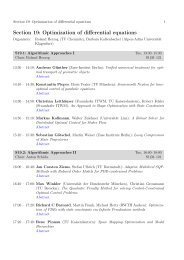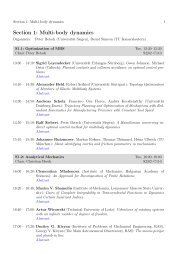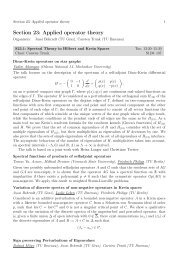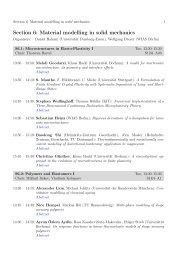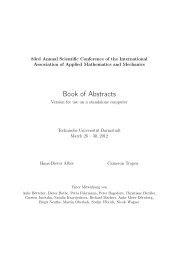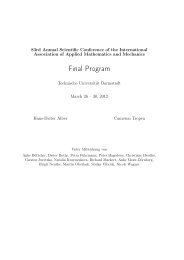Section 6: Material modelling in solid mechanics - GAMM 2012
Section 6: Material modelling in solid mechanics - GAMM 2012
Section 6: Material modelling in solid mechanics - GAMM 2012
You also want an ePaper? Increase the reach of your titles
YUMPU automatically turns print PDFs into web optimized ePapers that Google loves.
16 <strong>Section</strong> 6: <strong>Material</strong> <strong>modell<strong>in</strong>g</strong> <strong>in</strong> <strong>solid</strong> <strong>mechanics</strong><br />
asphalt cover layer, i.e. the top layer of the entire asphalt-construction. In order to predict the<br />
macro-scale effective material properties of asphalt we apply a numerical homogenisation scheme<br />
based on volume averag<strong>in</strong>g techniques. The ma<strong>in</strong> advandtage of this numerical approach is, that<br />
the effective material properties can be determ<strong>in</strong>ed <strong>in</strong> knowledge of the micro-scale properties.<br />
Hence, the first step towards an overall model for bitum<strong>in</strong>ous asphalt is the quantification of<br />
the micro-scale mechanical properties. Aga<strong>in</strong>st the background of <strong>solid</strong>-borne acoustical properties<br />
we restrict ourselves to a geometrically l<strong>in</strong>ear description <strong>in</strong>volv<strong>in</strong>g only small deformations<br />
on both, macro- and micro-scale. Do<strong>in</strong>g so, the l<strong>in</strong>ear-elastic properties of the stiff, granular filler<br />
can be adopted from relevant literature. The viscoelastic behaviour of the bitum<strong>in</strong>ous phase is<br />
characterized by rheological experiments (dynamic shear rheometer with plate-plate geometry).<br />
The numerical implementation on the micro-scale is realized us<strong>in</strong>g a generalized Zener model (3d).<br />
Mak<strong>in</strong>g use of the numerical homogenization approach, the effective viscoelastic properties on<br />
the macro-scale are <strong>in</strong>vestigated with<strong>in</strong> transient experiments (relaxation/creep test). In particular<br />
we are <strong>in</strong>terested <strong>in</strong> the particular relaxation mechanisms and the related characteristic frequencies<br />
to be observed on the macro-scale. The <strong>in</strong>fluence of micro-scale boundary conditions will be<br />
taken <strong>in</strong>to account. In order to study the <strong>in</strong>teraction between micro-constituents as well as their<br />
geometrical morphology on the one hand and the effective viscoelastic properties on the other,<br />
we <strong>in</strong>troduce artificially produced periodic unit cells based on simplified geometries with vary<strong>in</strong>g<br />
volume and surface fractions of the m<strong>in</strong>eral filler.<br />
Jumps of the critical track<strong>in</strong>g load<strong>in</strong>gs for viscoelastic beams with vanisih<strong>in</strong>g <strong>in</strong>ternal<br />
viscosity<br />
S.A.Agafonov (Moscow State Technical University), D.V.Georgievskii (Moscow State University)<br />
Transverse vibrations of a viscoelastic beam under action of a track<strong>in</strong>g load<strong>in</strong>g are considered.<br />
The constitutive relation represents the follow<strong>in</strong>g non-l<strong>in</strong>ear connection of stress σ(t), stra<strong>in</strong> ε(t)<br />
and stra<strong>in</strong> rate ˙ε(t):<br />
σ = Eε +<br />
where E is the Young modulus, k (n)<br />
i<br />
N<br />
n<br />
n=1 i=1<br />
k (n)<br />
i ε2(n−i) ˙ε 2i−1 , N ≥ 1<br />
> 0 are the coefficients of <strong>in</strong>ternal viscosity.<br />
Analytical and numerical <strong>in</strong>vestigation of dynamic stability <strong>in</strong> case N = 3, k (1)<br />
1 = 0, k (2)<br />
1 = 0,<br />
k (1)<br />
2 = 0 shows that if k (3)<br />
α → 0 (k (3)<br />
β<br />
= 0, k(3)<br />
γ = 0; (α, β, γ) may be some permutation of (1, 2, 3))<br />
then three critical values of track<strong>in</strong>g load<strong>in</strong>g correspond<strong>in</strong>g to each nonzero coefficient of viscosity<br />
k (3)<br />
α less than the value for elastic system by a f<strong>in</strong>ite quantity.<br />
Numerical model<strong>in</strong>g of a non-l<strong>in</strong>ear viscous flow <strong>in</strong> order to determ<strong>in</strong>e how parameters<br />
<strong>in</strong> constitutive relations <strong>in</strong>fluence the entropy production<br />
Wolfgang H. Müller, B. Emek Abali (TU Berl<strong>in</strong>)<br />
Some rheological materials like melt<strong>in</strong>g polymers, cosmetic creams, ketchup, toothpaste can be<br />
modeled as non-Newtonian fluids by us<strong>in</strong>g a non-l<strong>in</strong>ear constitutive relation. Flow of this k<strong>in</strong>d<br />
of amorphous matter can be considered as a thermodynamic process, and a solution of pressure,<br />
velocity and temperature fields describe it fully. S<strong>in</strong>ce flow processes are generally irreversible,<br />
entropy is produced lead<strong>in</strong>g to dissipation <strong>in</strong> the system. This energy loss can be measured<br />
<strong>in</strong>directly <strong>in</strong> a cone/plate viscometer which is used to determ<strong>in</strong>e viscosity of a B<strong>in</strong>gham fluid.<br />
While dissipation is a measurable quantity we want to be able to calculate it. Thus the goal of<br />
this work is to expla<strong>in</strong> how to calculate entropy production us<strong>in</strong>g balance equations <strong>in</strong> a spatial



